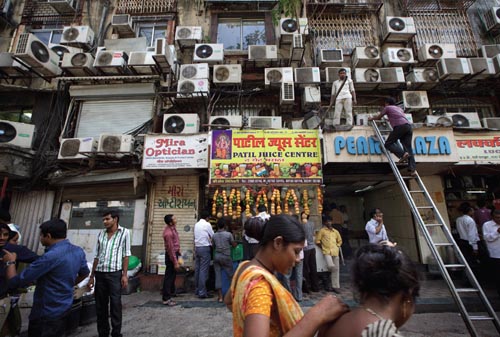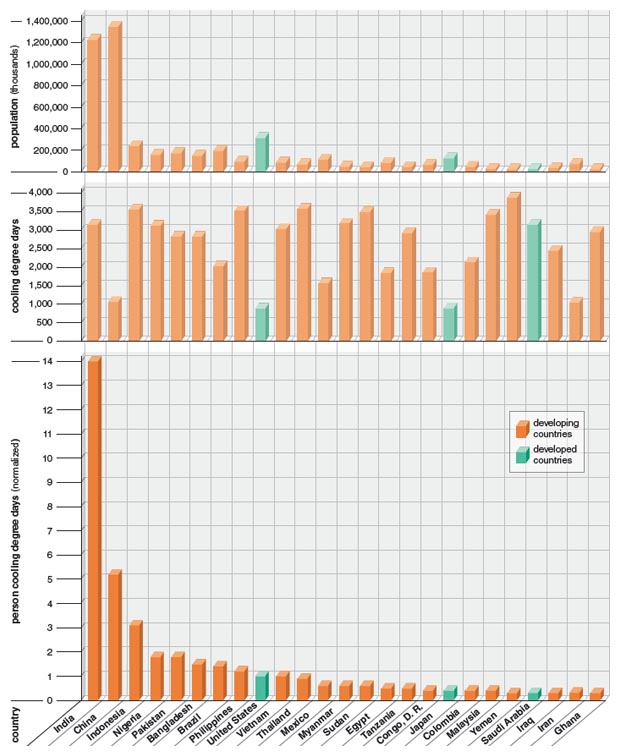Will AC Put a Chill on the Global Energy Supply?
By Michael Sivak
Several developing nations could soon lead the world in use of air-conditioning.
Several developing nations could soon lead the world in use of air-conditioning.

DOI: 10.1511/2013.104.330
The United States currently uses more energy for air-conditioning than all other countries combined—a sobering statistic from Stan Cox of the Land Institute in Salina, Kansas. That distinction might not remain true for long, however. Several developing countries rank among both the most populous and hottest areas in the world. As personal incomes rise in those countries, their use of air-conditioning will also likely go up, which in turn could lead to an unprecedented increase in energy demand. I have estimated that in metropolitan Mumbai alone, the large population and hot climate combine to create a potential energy demand for cooling that is about a quarter of the current demand of the entire United States.

Kuni Takahashi
According to the U.S. Energy Information Administration, 87 percent of American households are equipped with air-conditioning, and the United States expends about 185 billion kilowatt hours of energy annually on residential cooling. Therefore, it is not surprising that researchers frequently use the United States as a yardstick of high air-conditioning usage. For example, energy consultant George Henderson has recently projected how much energy might be used in the future in various European cities, should the usage of air-conditioning there follow the U.S. pattern. Energy analysts Michael McNeil and Virginie Letschert of the Lawrence Berkeley National Laboratory have projected how much air-conditioning households in developing countries might use if cooling were more affordable to them, again using the United States as a baseline. However, McNeil and Letschert analyzed large regions of the world and considered only a small number of specific countries.
Rapid increases in the ownership of air conditioners are already occurring in many developing countries. According to research by McNeil and Letschert, the percentage of urban Chinese households with an air conditioner jumped from less than 1 percent in 1990 to 62 percent in 2003. In 2010 alone, 50 million air-conditioning units were sold in China. In another key developing country—India—only 2 percent of households had air-conditioning in 2007. But the situation is changing quickly: McNeil and Letschert estimated that air-conditioning sales there are growing by about 20 percent a year.
As personal incomes rise in developing countries, use of air-conditioning will likely go up, leading to an unprecedented increase in energy demand.
As more people around the world adopt air-conditioning, the energy demands in developing countries are certain to increase. At the same time, climate change is expected to make cooling demands even greater than they are today. Morna Isaac and Detlef van Vuuren of the Netherlands Environmental Assessment Agency assessed future residential energy use for cooling in the world in the context of potential climate change. They estimated that by 2100 worldwide energy demand for air-conditioning could increase by 72 percent as a result of climate change alone.
To gain a greater understanding of potential future air-conditioning needs in each of the countries around the world, I conducted an analysis that takes into account two primary factors: a country’s local climate and the size of its population.

Tom Dunne
The climate is represented through a measure known as cooling degree days, which provides an index of the energy demand required to cool indoor spaces. The cooling-degree-days index is calculated by subtracting 18 from the mean daily outdoor temperature in degrees Celsius and summing up only positive values over a fixed period, such as an entire year. The selection of 18 degrees as the base outdoor temperature accounts for the additional heat generated by occupants and their activities, resulting in an average indoor temperature of 21 degrees—typical room temperature—when it is 18 degrees outdoors. For an average outdoor temperature higher than 18 degrees, most buildings require cooling to maintain a 21-degree indoor temperature.
My calculations used a pair of underlying variables, the annual cooling degree days for each country (weighted by the geographical distribution of the population) and the country’s total population (using figures for 2010). Examples of the values of these two variables are shown in the graphs at right.
The specific calculations involved two steps: deriving annual person cooling degree days—an index of the potential demand for energy for cooling—as a product of these two variables, and then normalizing the product with respect to the corresponding value in the United States. This index estimates what the energy usage would be in each country if air-conditioning became as prevalent there as it is in the United States. Examples of the final results are shown in the graphs above. The analysis was performed for the 170 countries that were common to both sets of underlying data.
The results indicate that of the top 25 countries in terms of person cooling degree days, 14 are in Asia, 7 are in Africa, and 2 each are in North and South America. The United States ranks as number 9, despite the fact that it has the coolest climate of these 25 countries (meaning it has the lowest number of cooling degree days before multiplying by population).
Three notable findings emerged from studying the potential energy demand for air-conditioning in these 170 countries. First, eight countries have the potential to exceed the United States’ yardstick of high air-conditioning usage, because of their warm climates and significant populations. Furthermore, the top three could surpass the United States by substantial amounts: India, China, and Indonesia by factors of 14, 5.2, and 3.1, respectively, if they adopt American standards of cooling.

Imagechina/Corbis
Second, among the top 25 countries, 22 are below the World Bank income limit for developing countries. Hence, the current cooling demand there is nowhere near the possible peak.
Third, the total demand in the 169 countries analyzed (excluding the United States) has the potential for cooling-energy demand that is 45 times greater than in the United States today. More broadly, the future demand in all countries of the world outside of the United States—the United Nations currently lists 229 of them—has the potential to exceed the demand in the United States by a factor of 50.
Several caveats are in order. Cooling degree days, being a temperature measure, does not represent all factors that are relevant to the potential demand for cooling. Some other considerations include the extent of local cloud cover, humidity, the amount of interior space to be cooled per person, and differences in dwelling construction and their effects on thermal insulation. Variations in the energy efficiency of air conditioners across countries were not included in this analysis. In addition, cultural differences in the tolerance of hot temperatures and in environmental responsibility were beyond the scope of this study.
Because of these limitations, the present calculations should be viewed only as first approximations of the potential future energy demand for air-conditioning. Nevertheless, it is clear that the global energy demand for air-conditioning will grow substantially as nations become more affluent, with the consequences of climate change potentially accelerating the demand. This trend will put additional strain not only on global energy resources but also on the environmental prospects of a warming planet.
Several institutions have recently made major technical advances in the design of more energy-efficient air conditioners. For example, developments at the National Renewable Energy Laboratory suggest that efficiency improvements of 20 to 70 percent are possible compared to current models of air conditioners. Changes in housing design and urban planning are also needed, but such changes require more time and resources for implementation. The data I presented here emphasize the urgency to accelerate progress in all relevant areas.
Click "American Scientist" to access home page
American Scientist Comments and Discussion
To discuss our articles or comment on them, please share them and tag American Scientist on social media platforms. Here are links to our profiles on Twitter, Facebook, and LinkedIn.
If we re-share your post, we will moderate comments/discussion following our comments policy.